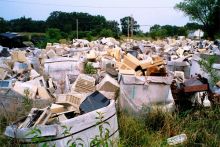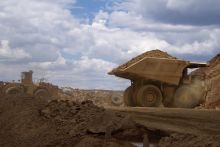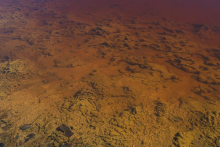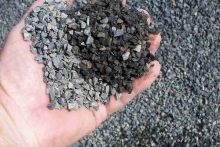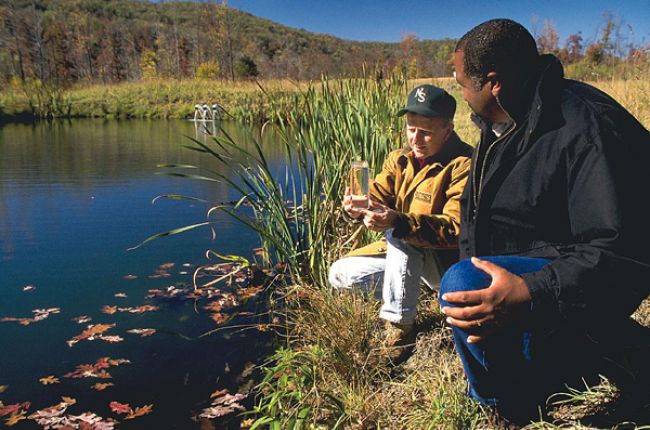
Material adapted from: Hudson, T.L, Fox, F.D., and Plumlee, G.S. 1999. Metal Mining and the Environment, p. 48-49. Published by the American Geosciences Institute Environmental Awareness Series. Click here to download the full handbook.
An extensive regulatory system has been developed to govern current mining operations in the United States, as well as to guide the cleanup of historical ones. The framework for mining regulation is primarily based on federal laws dating back to the late 1960s. In many cases, these regulatory responsibilities have been delegated to state agencies, which have in turn developed their own sets of environmental laws, regulations, and standards. Regulatory standards established at state levels are commonly equal to or more stringent than federal standards.
Federal laws that regulate mining
National Environmental Policy Act (NEPA)
The NEPA, passed in 1969, established the basic environmental policies for the nation. NEPA defines processes for evaluating and communicating the environmental consequences of Federal decisions and actions, such as the permitting of new mine development on Federal lands. The processes established by NEPA are used by concerned parties to ensure that environmental considerations are included in Federal decisions. NEPA applies to mining operations that require Federal approvals.
The CAA, passed in 1970, authorizes regulations to address airborne pollution that may be potentially hazardous to human health or natural resources. Efforts to combat urban air pollution, such as emission controls on cars, are well-known examples of regulations developed under CAA. Examples of mining-related situations that are covered by CAA-based regulations include dust emissions that accompany operations or tailings disposal in impoundments, exhaust emissions from heavy equipment, and emissions from processing facilities, such as smelters.
Resource Conservation and Recovery Act (RCRA)
The RCRA, passed in 1976, focuses on preventing the release of hazardous wastes into the environment by providing for their management from generation to disposal. Most mining, milling, and smelting solid wastes, like those discussed in this booklet, are “high-volume, low-hazard” materials that have been exempt from regulation under RCRA. Regulation of high-volume, low-hazard mining wastes is now the primary responsibility of the states.
The CWA, passed in 1977, authorizes regulations that cover discharges of toxic and nontoxic pollutants into the surface waters of the nation. The CWA’s goal is to make all surface waters safe and eventually to stop all harmful discharges. One of the principal tools established by CWA is a permitting system for surface water discharges, known as the National Pollutant Discharge Elimination System. CWA-based regulations cover such mining-related situations as the disposal of mining-related waters, the pumping or draining of mine water to the surface, storm water runoff in mining operation areas, and control of seeps from mine tailings impoundments.
Toxic Substances Control Act (TSCA)
The TSCA, passed in 1977, focuses on controlling the development and application of new and existing chemical substances. Chemicals and hazardous materials used in the processing of ore or ore concentrates, such as sodium cyanide solutions used in the leaching of gold ores, are regulated under TSCA.
Comprehensive Environmental Response, Compensation, and Liability Act (CERCLA)
The CERCLA, passed in 1980, enables the government to clean up any site where there is an unremedied release of a hazardous substance. Hazardous substances are broadly defined under CERCLA and have included mining, milling, and smelter wastes that are currently excluded from regulation under RCRA. Regulators have the authority to use special funds, undertake emergency responses, and hold all historical owners or contributors — principal responsible parties — liable for cleanup costs. The definitions of liability are very broad and controversial under CERCLA and provide regulators tremendous enforcement powers. Because of its funding aspects, this act is commonly referred to as “Superfund”.
Learn More
- Metal Mining and the Environment (Booklet), American Geosciences Institute
Provides basic information about the mining cycle, from exploration for economic mineral deposits to mine closure. The booklet discusses the environmental aspects of metal mining and illustrates the ways science and technology assist in preventing or reducing environmental impacts.
- Regulatory Information by Sector: Mining (Except Oil and Gas) (Webpage), Environmental Protection Agency
Links to information on laws and regulations that regulate mining activities related to air quality, asbestos, waste, and water.
- Contact your state mining agency: Links to State Mining Agencies, Mine Safety and Health Administration


